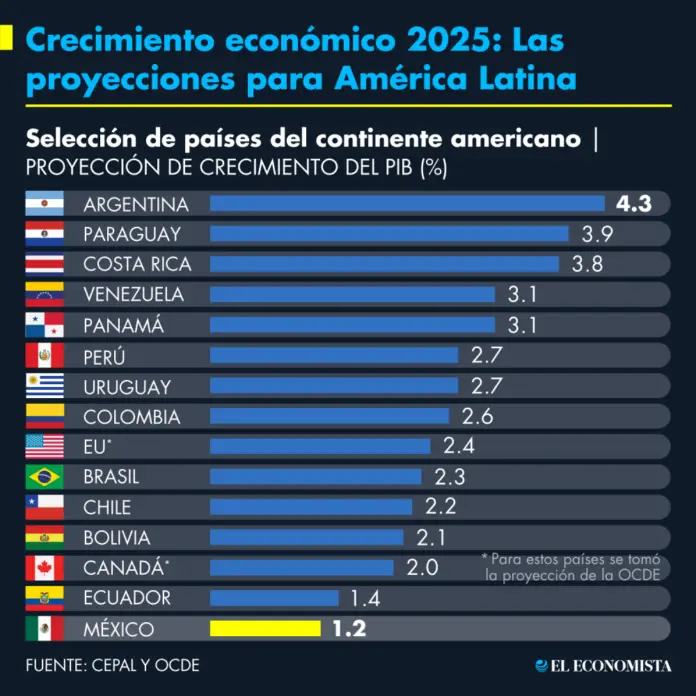The economic outlook for 2025 is not the most encouraging, at least not for Mexico. In the comparison of the region, the national economy occupies one of the last places in the growth projections, surpassed only by Haiti and Cuba.
The Economic Commission for Latin America and the Caribbean (ECLAC) was the last organization to present its growth prospects at the end of 2024. For Mexico, it projects a 1.2% advance in the Gross Domestic Product (GDP) this year, a reduction of 0.7 points compared to the estimate of 1.9% it presented last August.
“By 2025, ECLAC estimates that Mexico’s GDP will increase by 1.2% in real terms, mainly due to the economic slowdown in the United States and the uncertainty of the arrival of investments and the international environment, particularly in the commercial part,” the organization highlights in the Preliminary Overview of the Economies of Latin America and the Caribbean 2024.
Even when presenting the report, the executive secretary of ECLAC, José Manuel Salazar-Xirinachs, highlighted that this panorama could be further deteriorated by the protectionist trade policies announced by Donald Trump, who will assume his second term as president of the United States on January 20.
“There are estimates that if Trump were to implement a tariff not of 25%, but of 10%, Mexican exports and investment would be affected, leading to GDP growth between 0.8 and 1 percentage point lower without these tariffs,” he said.
For the rest of the economic variables in the country, ECLAC estimates that in 2025 inflation will be 4.0%, an unemployment rate of 3.5%, a fiscal deficit of the non-financial public sector equivalent to 4.0% of GDP and total net public debt at a level of 51.0% of GDP.
Shared growth projection
This same growth projection (1.2%) is the one that the Organization for Economic Cooperation and Development (OECD) has for the Mexican economy in 2025. It is also the lowest of the comparison of the region made by the group, which includes Argentina (3.6%), Brazil (2.3%), Chile (2.3%), Colombia (2.7%), Costa Rica (3.5%) and Peru (2.8%).
For the United States and Canada, meanwhile, the organization estimates that their economies will grow 2.4 and 2.0%, respectively.
“The (Mexican) economy is expected to grow moderately, reaching 1.4% in 2024, 1.2% in 2025 and 1.6% in 2026. This continued growth reflects a decrease in inflationary pressures, which will help sustain consumption, and a gradual decline in interest rates, which will stimulate investment despite fiscal consolidation efforts in 2025. Export growth is expected to remain solid, driven by favourable economic conditions in the United States,” highlights the OECD Economic Outlook: Focus on Latin America report published in December.
Other organizations have also reduced growth expectations for Mexico. The International Monetary Fund (IMF) cut its GDP growth estimate from 2.2 to 1.5%.
Meanwhile, private sector analysts consulted monthly by the Bank of Mexico project that the economy will grow by 1.17 percent in 2025.
The most optimistic forecast is that of the federal government. The Ministry of Finance considers a GDP growth projection of 2.3% this year.
Growth of the economies of the continent
ECLAC estimates that the economy of Latin America and the Caribbean will grow by 2.4% this year, which implies that in the last decade (2015-2024) the average annual growth has been 1%, with “a stagnation of the GDP per capita during that period.”
“The economies of the region will continue this year and next to be mired in a trap of low capacity to grow, with growth rates that will remain low and with a growth dynamic that depends on private consumption, and less on investment,” the report states.
According to data from ECLAC and the OECD, this would be the projection of economic growth in 2025 for the countries of the American continent, ordered from highest to lowest GDP growth:
Dominican Republic, 4.6%
Argentina, 4.3%
Paraguay, 3.9%
Costa Rica, 3.8%
Guatemala, 3.5%
Nicaragua, 3.3%
Honduras, 3.2%
Panama, 3.1%
Venezuela, 3.1%
El Salvador, 3.0%
Peru, 2.7%
Uruguay, 2.7%
Colombia, 2.6%
United States, 2.4%
Brazil, 2.3%
Chile, 2.2%
Bolivia, 2.1%
Canada, 2.0%
Ecuador, 1.4%
Mexico, 1.2%
Cuba, -0.1%
Haiti, -0.5%
“Addressing the low growth capacity trap requires, on the one hand, increasing the capacity of economies to mobilize financial resources effectively, in order to strengthen resilience to economic fluctuations, and on the other, strengthening productive capacity in the medium and long term, through the adoption of productive development policies aimed at increasing productivity, promoting investment in productive capital and generating quality employment,” said ECLAC Executive Secretary José Manuel Salazar-Xirinachs.
Source: eleconomista




